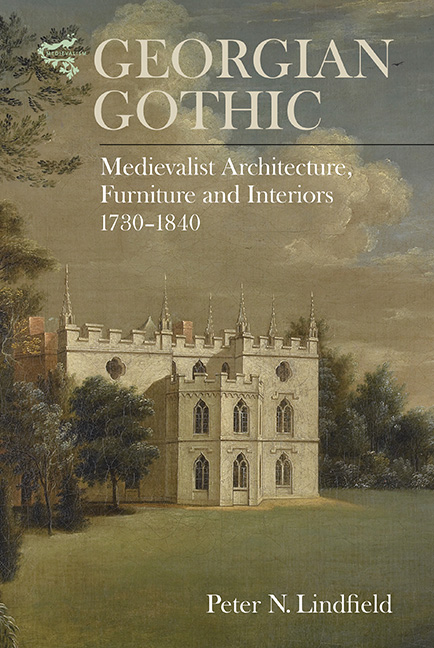Book contents
- Frontmatter
- Dedication
- Miscellaneous Frontmatter
- Contents
- List of Illustrations
- Acknowledgements
- Introduction: the Gothic Aesthetic in Britain and British Furniture, 1730–1840
- 1. Understanding Gothic Architecture in Georgian Britain
- 2. Creation of Classical Gothic Architecture, Furniture and Interiors
- 3. High Fashion and Fragments of the Past: the Omnipresence of Rococo Gothic
- 4. Fluctuating Tastes: Gothic in Later Eighteenth-century Britain
- 5. The ‘Chaos of Modern Gothic Excrescences’: Regency to Revolution
- Conclusion
- Appendix
- Bibliography
- Glossary
- Index
- Miscellaneous Endmatter
5. - The ‘Chaos of Modern Gothic Excrescences’: Regency to Revolution
Published online by Cambridge University Press: 25 October 2017
- Frontmatter
- Dedication
- Miscellaneous Frontmatter
- Contents
- List of Illustrations
- Acknowledgements
- Introduction: the Gothic Aesthetic in Britain and British Furniture, 1730–1840
- 1. Understanding Gothic Architecture in Georgian Britain
- 2. Creation of Classical Gothic Architecture, Furniture and Interiors
- 3. High Fashion and Fragments of the Past: the Omnipresence of Rococo Gothic
- 4. Fluctuating Tastes: Gothic in Later Eighteenth-century Britain
- 5. The ‘Chaos of Modern Gothic Excrescences’: Regency to Revolution
- Conclusion
- Appendix
- Bibliography
- Glossary
- Index
- Miscellaneous Endmatter
Summary
This modern Gothic (‘castellated’) style, which looks so fairy-like on paper, in reality often strikes one not only as tasteless, but even somewhat absurd, from its overloaded and incongruous air.
(Hermann Pückler-Muskau, 1827)GOTHIC REVIVAL ARCHITECTURE, furniture and interiors were not especially popular nor universally approved of in the early nineteenth century, as the observation by Prince Hermann von Pückler-Muskau (1785–1871) above demonstrates. Furniture-makers predominantly supplied pieces according to the Neoclassical patterns of George Hepplewhite (c.1727–86) and Thomas Sheraton (1751–1806), or in the Greek and Egyptian Revival styles promoted by Thomas Hope (1769–1831) in his pattern-book, Household Furniture and Interior Decoration (1808). The year 1808, however, was an important one for Gothic Revival design: twenty-two plates in George Smith's A Collection of Household Furniture and Interior Decoration. In the Most Approved and Elegant Taste depict furniture and rooms inspired by medieval architecture. Smith's Gothic furniture ranges from modest parlour- and hall chairs (Plates 36 and 37), through bookcases (Plate 103), to an exceptionally grand and architecturally rich state bed covered by a Gothic baldachin (Plate 28). Writing about the state bed, Smith's description indicates the growing respect accorded to Gothic design at the start of the nineteenth century:
There is no kind of work better calculated to produce a grand effect, so far as relates to furniture, than what is usually called Gothic, as is shown in the present Design, admitting of a more abundant variety of ornaments and forms than can possibly be obtained in any other style: and as many of the mansions of our Nobility and Gentry are at this time finished in a similar taste, this Design may not be deemed unacceptable.
However, Smith also warned of the disastrous consequences attendant upon the mixing of the style with non-Gothic or Classical architecture: ‘it is needless perhaps to add, this style is applicable only in a real Gothic mansion; if otherwise used, it would be highly improper and out of taste’.3 Gothic Revival furniture also began to appear under the slogan of ‘fashionable furniture’ in Rudolph Ackermann's influential monthly serial The Repository of Arts from 1810, with an especially large number of plates appearing in 1813 (seven), 1826 (twelve), and 1827 (ten). Indeed, the volumes for 1826 and 1827 present only Gothic furniture designs. Between 1809 and 1828 approximately a quarter of the fashionable furniture designs were Gothic.
- Type
- Chapter
- Information
- Georgian GothicMedievalist Architecture, Furniture and Interiors, 1730-1840, pp. 180 - 221Publisher: Boydell & BrewerPrint publication year: 2016



